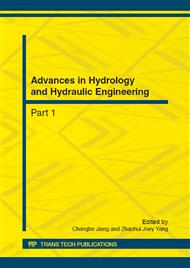p.72
p.78
p.83
p.88
p.99
p.104
p.108
p.113
p.117
Grid Based Change Trend of Precipitation and its Regional Difference in China over the Past 40 Years
Abstract:
First, the software ANUSPLIN4.3 was used to process 40-year observed precipitation data from 680 meteorological stations of China to generate grid precipitation data sets at resolution of 1km by 1km. Second, one-dimensional linear regression method and ArcGIS software were applied to analyze trend of precipitation change and its regional difference in China over the past 40 years. The results showed that general trend of precipitation change in nation-wide was not obvious but its regional difference clear. Precipitation in southeast coast areas rose obviously with a maximum of 5 millimeters per year, dropped in central areas including Circum-Bohai-Sea region, Shanxi, Shaanxi and south of Gansu. There was no obvious change trend of precipitation in the rest areas of China.
Info:
Periodical:
Pages:
99-103
Citation:
Online since:
October 2012
Authors:
Keywords:
Price:
Сopyright:
© 2012 Trans Tech Publications Ltd. All Rights Reserved
Share:
Citation:


